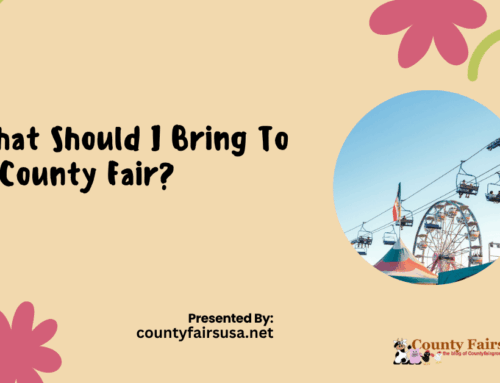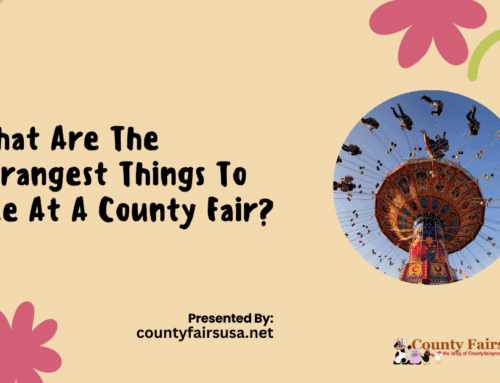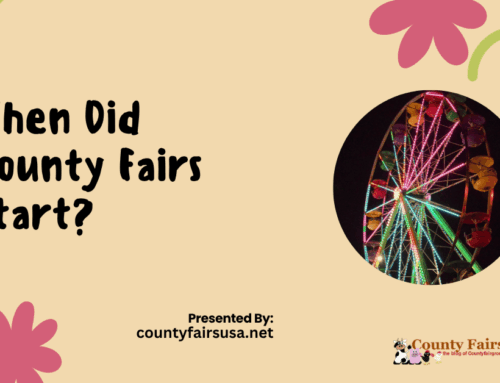The rumble of engines, the scent of funnel cakes, and the distant cheers of crowds—these sensory experiences instantly transport us to the heart of America’s beloved county fairs. While many visitors come for the agricultural exhibitions and carnival rides, the true spectacles that draw record attendance are the high-energy events that have become synonymous with fair culture across the country.
Biggest County Fair Events Across the U.S.
County fairs have evolved from their humble beginnings as agricultural showcases in the early 19th century. Today, they represent a perfect blend of tradition and contemporary entertainment, with attendance figures demonstrating their enduring appeal. According to the International Association of Fairs and Expositions, over 150 million people attend county and state fairs annually in North America—clear evidence that these events remain deeply woven into the cultural fabric of communities nationwide.
Let’s explore the most thrilling attractions that make county fairs must-visit destinations for excitement-seekers of all ages.
Rodeos: The Classic County Fair Attraction
The rhythmic announcer’s voice echoes across the arena as a cowboy adjusts his grip, the gate swings open, and eight seconds of pure adrenaline unfolds. Rodeos stand as perhaps the most iconic county fair events, with roots tracing back to the working practices of American cowboys in the 1800s.
The transformation from practical ranch skills to competitive events occurred naturally as cowboys began informally competing to demonstrate their abilities. By the early 20th century, rodeos had become formalized attractions at county fairs across the western United States, eventually spreading nationwide.
Modern county fair rodeos typically feature several standard events:
- Bull Riding: Often called the “most dangerous eight seconds in sports,” this event requires riders to stay mounted on a bucking bull using only one hand for balance
- Barrel Racing: Primarily featuring female competitors, this timed event has riders guide horses through a cloverleaf pattern around barrels
- Team Roping: A demonstration of precision and teamwork where two mounted riders attempt to rope and restrain a steer
- Saddle Bronc Riding: Considered rodeo’s classic event, riders must maintain proper form while atop a bucking horse
What separates county fair rodeos from larger professional circuits is their accessibility. While major rodeos like Cheyenne Frontier Days or the Calgary Stampede feature exclusively professional competitors, county fair rodeos often include amateur categories, giving local participants a chance to showcase their skills.
The Bloomsburg Fair in Pennsylvania and the Sonoma County Fair in California host particularly renowned rodeo events that attract competitors from across their respective regions. These smaller venues create an intimate atmosphere where spectators can fully appreciate the athleticism and courage on display.
Demolition Derbies: Crowd-Pleasing Destruction
There’s something undeniably captivating about watching vehicles collide in a cloud of steam and flying debris. Demolition derbies emerged in the post-World War II era when automobile abundance created the perfect conditions for a new form of entertainment. These events quickly found their home at county fairs, where they continue to draw massive crowds.
A typical demolition derby consists of multiple drivers in modified vehicles attempting to disable all other competitors’ cars by ramming into them. The last vehicle still operational wins—a simple premise that delivers complex entertainment.
Safety remains paramount despite the chaotic appearance. Modern demolition derbies require:
- Removal of all glass and flammable materials
- Reinforced driver doors
- Functioning seat belts and helmets
- Fire extinguishers within reach
- Specially designed fuel tanks to prevent leakage
The variety of vehicle categories adds another dimension to these events. While full-size American sedans from the 1960s-1980s were once the standard, today’s derbies often include compact car divisions, van categories, and even lawnmower derbies for younger participants.
The Yolo County Fair in California has developed a reputation for hosting particularly competitive demolition derbies, with participants preparing their vehicles months in advance. Meanwhile, the Great Frederick Fair in Maryland draws thousands of spectators to its demolition events, often selling out its grandstand seating.
Tractor Pulls: Raw Power on Display
The deafening roar of modified engines and the sight of massive machines straining against seemingly impossible loads—tractor pulls represent the perfect blend of agricultural tradition and motorsport excitement at county fairs.
These competitions began as straightforward demonstrations of farming equipment power, with standard tractors pulling weighted sleds. However, they’ve evolved into sophisticated events featuring highly specialized pulling vehicles producing upwards of 10,000 horsepower.
The science behind tractor pulls adds an intellectual dimension to the raw spectacle. As competitors pull the sled, a weight transfer system gradually increases resistance by moving metal weights forward on the sled, creating increasingly difficult conditions. This requires drivers to perfectly calibrate their approach, balancing power delivery with traction management.
Different weight classes and divisions ensure variety throughout the event:
- Farm Stock: Unmodified working tractors
- Super Farm: Limited modification production tractors
- Modified: Purpose-built pulling tractors with automotive engines
- Super Modified: Multi-engine monsters with aircraft or tank engines
Regional variations exist across the country. Midwest fairs often showcase the most competitive pulling events due to the region’s strong agricultural heritage. The Elkhart County 4-H Fair in Indiana hosts one of the nation’s most respected tractor pull competitions, while the Canfield Fair in Ohio attracts top competitors from multiple states.
Monster Truck Shows: Larger-Than-Life Action
Few county fair spectacles command attention quite like monster trucks—12-foot-tall, 10,000-pound vehicles performing gravity-defying stunts that leave audiences breathless. These events have undergone a remarkable evolution since their inception in the late 1970s.
Today’s monster truck shows feature two primary competition formats:
- Racing: Head-to-head elimination competitions over obstacle courses
- Freestyle: Judged performances where drivers perform jumps, donuts, and even backflips
The family-friendly nature of monster truck shows makes them particular draws at county fairs. Children and adults alike connect with the personalized nature of these vehicles, from classics like Grave Digger and Bigfoot to newer fan favorites.
What many spectators don’t realize is the technological sophistication behind these mechanical beasts. Modern monster trucks feature:
- Custom-built tubular chassis with advanced roll cage design
- Specialized nitrogen-charged shock absorbers costing thousands per corner
- Remote engine kill switches and restraint systems
- Fiberglass bodies designed to break away on impact
The DuQuoin State Fair in Illinois and the San Diego County Fair in California have developed reputations for hosting particularly impressive monster truck exhibitions, often bringing in the most recognized names in the sport for their events.
Animal Competitions Beyond Livestock
While traditional livestock judging remains a cornerstone of county fair culture, a diverse array of animal events has emerged to entertain modern fairgoers. These competitions combine the agricultural foundation of fairs with accessible entertainment value.
Dog agility shows have become particularly popular additions to county fair schedules. These events showcase the remarkable bond between handlers and their canine companions as they navigate obstacle courses requiring precision, speed, and communication. The Wisconsin State Fair and the Big E (Eastern States Exposition) in Massachusetts host especially well-attended dog events.
Racing competitions featuring unexpected animals deliver unique entertainment value. Pig races—where young swine navigate oval tracks with cookie rewards—consistently draw standing-room-only crowds. Similarly, duck races and even turtle races provide family-friendly amusement while maintaining connections to animal husbandry.
The educational component of these events shouldn’t be overlooked. Many county fairs incorporate information about animal behavior, conservation, and responsible ownership into their presentations, creating entertainment with lasting value.
Concert Series: Star Power at County Fairs
As the sun sets over fairgrounds across America, stages light up with musical performances that have become increasingly central to the county fair experience. These concert series represent significant investments for fair organizers but deliver tremendous attendance value.
The diversity of musical acts appearing at county fairs might surprise casual observers. While country music remains a staple—with artists like Luke Combs and Miranda Lambert performing at multiple county fairs in recent years—rock, pop, and even hip-hop acts regularly appear on fair schedules.
This musical variety reflects county fairs’ evolution into events with broad demographic appeal. Booking strategies typically include:
- Nostalgia acts appealing to older attendees
- Contemporary artists attracting younger demographics
- Regional favorites with established local followings
- Rising stars offering value entertainment
The Del Mar Fair in California exemplifies this approach, having hosted performers ranging from Toby Keith to Ice Cube. Similarly, the Erie County Fair in New York allocates significant resources to secure national touring acts alongside agricultural competitions.
The Enduring Appeal of County Fair Events
County fairs have demonstrated remarkable resilience in the digital entertainment era. Their continued success stems from offering experiences impossible to replicate through screens. the multi-sensory immersion of live events that connect communities with shared traditions.
The most successful county fairs understand this appeal, continually refreshing their offerings while maintaining core elements that resonate across generations. The Durham Fair in Connecticut exemplifies this approach, having operated continuously since 1916 while consistently evolving its entertainment lineup.
The statistics support this approach—according to industry surveys, attendance at county fairs has increased by approximately 10% over the past decade, with special events like demolition derbies and rodeos showing particularly strong growth.
For families seeking authentic experiences and communities looking to celebrate their heritage, county fairs deliver entertainment value extending far beyond agricultural exhibitions. The excitement of watching a championship rodeo, the spectacle of monster trucks defying physics, and the shared experience of live music create memories that last long after the fairgrounds empty.
As you plan your summer and fall activities, consider checking your local county fair’s schedule of events. You might be surprised by the world-class entertainment waiting just beyond the midway.
Follow Us On Facebook!










Leave A Comment